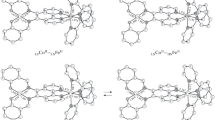Abstract
The phenomenon of the thermal spin transition, as observed for octahedral transition metal complexes having a d 4 to d 7 electronic configuration, can be fully rationalised on the basis of ligand field theory. In order to arrive at a self-consistent description of the vibronic structure of spin crossover compounds, it is essential to take into account the fact that the population of anti-bonding orbitals in the high-spin state results in a substantially larger metal-ligand bond length than for the low-spin state. Whereas the electron-electron repulsion is not affected to any great extent by such a bond length difference, the ligand field strength for iron(II) spin crossover compounds can be estimated to be almost twice as large in the low-spin state as compared to the one for the high-spin state. In fact, the dependence of the ligand field strength on the metal-ligand distance may be considered the quantum mechanical driving force for the spin crossover phenomenon.
Preview
Unable to display preview. Download preview PDF.
Similar content being viewed by others
References
a. Cambi L, Szego L, Cagnasso A (1931) Atti accad Lincei 13:168; b. Cambi L, Szego, L (1932) ibid 15:329; c. Cambi L, Szego L (1932) ibid 15:599
Bethe H (1929) Ann Physik 3:133
Van Vleck JH (1932) Theory of electric and magnetic susceptibilities. Oxford University Press, New York
a. Ewald AH, Martin RL, White AH (1964) Proc Roy Soc A 280:235; b. König E (1972) Berichte der Bunsengesellschaft für Phys Chem 76:975
Sugano S, Tanabe Y, Kamimura H (1970) Multiplets of transition metal ions, Pure and applied physics, Vol 33. Academic, New York
Shriver DT, Atkins PW, Langford CH (1990) Inorganic Chemistry, 3rd edn. Oxford University Press, New York
Jørgensen CK (1962) Absorption spectra and chemical bonding in complexes. Pergamon, Oxford, UK
a. Lever ABP (1984) Inorganic electronic spectroscopy, studies in physical and theoretical chemistry 33. Elsevier, Amsterdam; b. Figgis BN, Hitchman MA (2000) Ligand field theory and its Application, Wiley-VCH, New York
Schläfer HL, Gliemann G (1980) Einführung in die ligandenfeldtheorie. Akad Verlagsgesellschaft, Wiesbaden
Condon EU, Shortley GH (1951) The theory of atomic spectra. Cambridge University Press, Cambridge, UK
Ballhausen CJ (1962) Introduction to ligand field theory. McGraw-Hill, New York
Schäffer CE, Jørgensen CK (1958) J Inorg Nuclear Chem 8:143
a. Orpen AG, Brammer L, Frank HA, Kennard O, Watson DG, Taylor R (1989) J Chem Soc Dalton Trans, Suppl 171:S1; b. Montgomery H, Chastain RV, Natt JJ, Witowsak AM, Lingfelter E (1967) Acta Cryst 22:775; c. Dick S (1998) Zeitschrift für Kristallographie – New Crystal Structures 213:356
a. Hoselton MA, Wilson LJ, Drago RS (1975) J Am Chem Soc 97:1722; b. Katz BA, Strouse CE (1979) J Am Chem Soc 101:6214; c. Mikami M, Konno M, Saito Y (1982) Acta Cryst B38:452; d. Binstead RA, Beattie JK (1986) Inorg Chem 25:1481; e. Konno M, Mikami-Kido M (1991) Bull Chem Soc Jpn 64:339; f. Wiehl L, Kiel G, Köhler CP, Spiering H, Gütlich P (1986) Inorg Chem 25:1565; g. Letard JF, Guionneau P, Rabardel L, Howard JAK, Goeta AE, Chasseau D, Kahn O (1998) Inorg Chem 37:4432; h. van Koningsbruggen PJ, Garcia Y, Kahn O, Fournes L, Kooijman H, Spek AL, Haasnoot JG, Moscovici J, Provost K, Michalowicz A, Renz F, Gütlich P (2000) Inorg Chem 39:1891
Hauser A (1991) J Chem Phys 94:2741
Gütlich P, Hauser A, Spiering H (1994) Angew Chem Int Ed 33:2024
Slichter CP, Drickamer HG (1972) J Chem Phys 56:2142
a. Spiering H, Kohlhaas Th, Romstedt H, Hauser A, Bruns-Yilmas C, Kusz J, Gütlich P (1999) Coord Chem Rev 190–192:629; b. Hauser A, Jeftic J, Romstedt H, Hinek R, Spiering H (1999) Coord Chem Rev 190–192:471; c. Spiering H, this series (and references therein)
Drickamer HG, Frank CW (1973) Electronic transitions and the high pressure chemistry and physics of solids. Wiley, New York
Bousseksou A, Negre N, Goiran M, Salmon L, Tuchagues JP, Boillot ML, Boukheddaden K, Varret F (2000) Eur Phys J B13:451
Paulsen H, this series
Acknowledgements
I thank my friends and colleagues, in particular H. Spiering, for their help in the development of the ideas presented in this article. M. L. Daku Lawson’s critical reading of the manuscript is gratefully acknowledged. This work was financially supported by the Swiss Federal Office for Research and Education, grant No. 970559 within the European TMR project ERB-EMRX-CT98–0199, and by the Swiss National Science Foundation.
Author information
Authors and Affiliations
Corresponding author
Editor information
Rights and permissions
About this chapter
Cite this chapter
Hauser, A. Ligand Field Theoretical Considerations. In: Gütlich, P., Goodwin, H. (eds) Spin Crossover in Transition Metal Compounds I. Topics in Current Chemistry, vol 233. Springer, Berlin, Heidelberg. https://doi.org/10.1007/b13528
Download citation
DOI: https://doi.org/10.1007/b13528
Publisher Name: Springer, Berlin, Heidelberg
Print ISBN: 978-3-540-40394-4
Online ISBN: 978-3-540-44981-2
eBook Packages: Springer Book Archive




